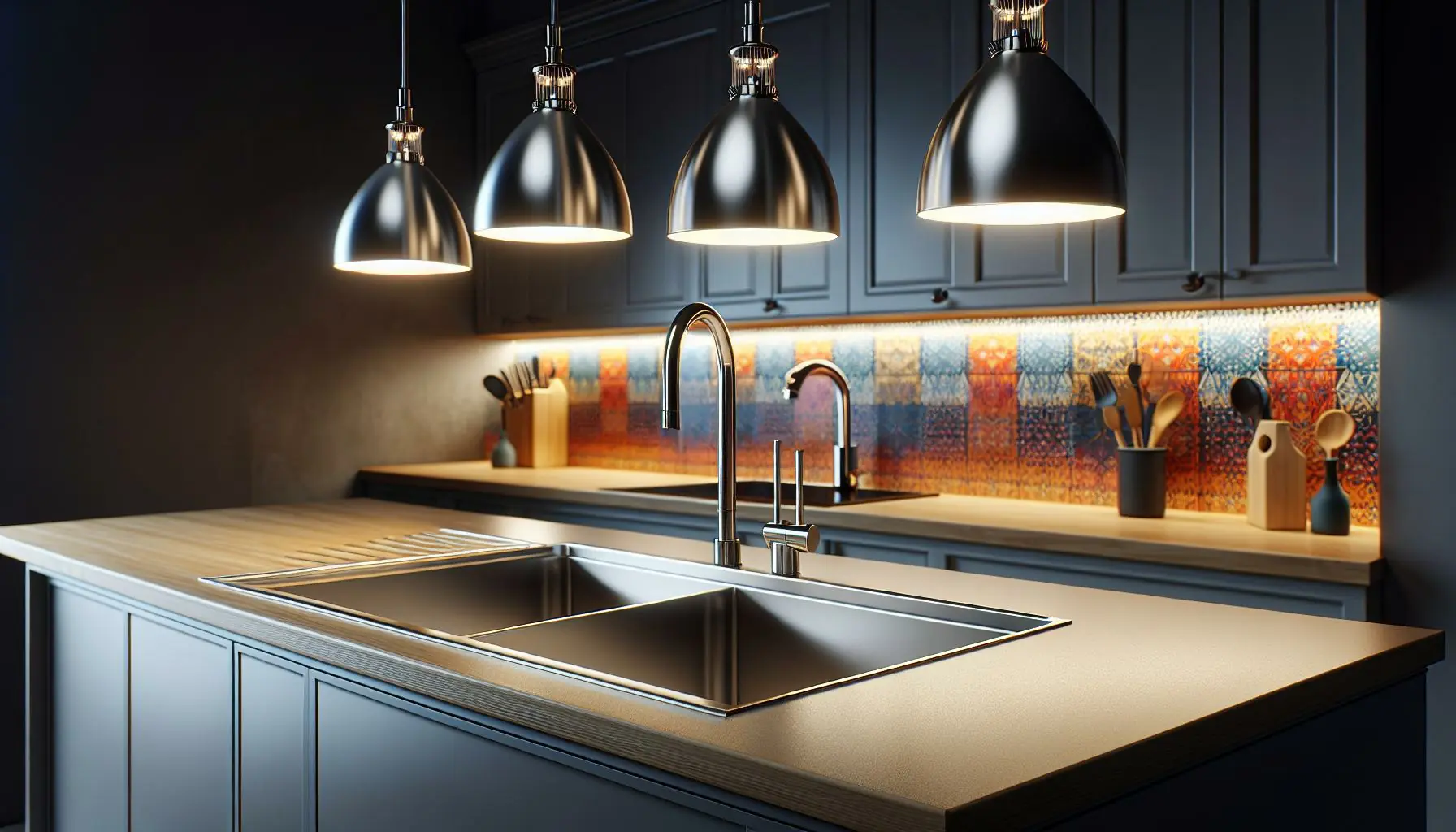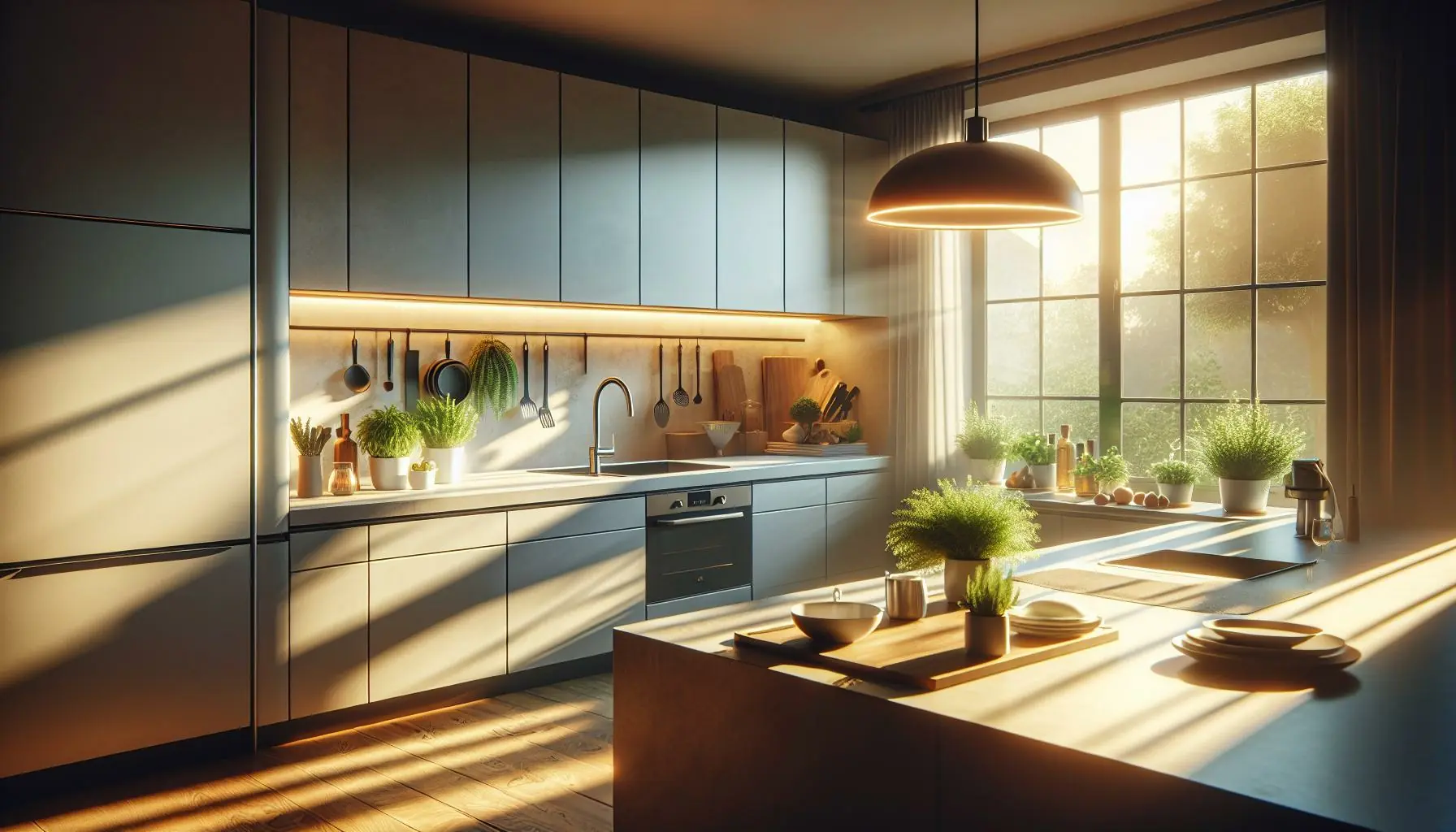I’ve helped countless homeowners transform their kitchen sink areas from dim and dreary to bright and functional. Over-sink lighting isn’t just about illuminating your workspace – it’s about creating the perfect blend of style and practicality in one of your kitchen’s most-used areas.
Whether you’re washing dishes scrubbing vegetables or reading recipes proper lighting above your sink can make all the difference. I’ve discovered that the right fixture can serve as both a task light and a design element brightening your space while adding personality to your kitchen. From pendant lights to recessed fixtures there’s an option for every style and budget that’ll enhance your kitchen’s functionality and aesthetic appeal.
Table of Contents
ToggleKey Takeaways
- Over-sink kitchen lighting comes in three main types: pendant lights, recessed lighting, and under-cabinet fixtures, each offering unique benefits for different kitchen layouts
- Proper lighting requires 800-1200 lumens for optimal task illumination, with color temperatures ranging from warm white (2700K) for ambiance to cool white (4000K) for detailed tasks
- Installation height is crucial – pendant lights should be mounted 30-36 inches above the sink surface, while under-cabinet lighting should be positioned 1.5 inches from the cabinet face
- Weather-resistant materials like marine-grade stainless steel and powder-coated aluminum are essential for durability in moisture-prone sink areas
- LED bulbs are the most energy-efficient choice, lasting up to 50,000 hours and consuming 75% less energy than traditional incandescent bulbs
- Regular maintenance, including weekly dusting and monthly deep cleaning, helps extend fixture lifespan and maintain optimal lighting performance
Types of Over Sink Kitchen Lighting
Over sink kitchen lighting comes in three distinct categories, each offering unique benefits for illuminating the sink workspace. Here’s a detailed look at each lighting option and its specific applications.
Pendant Lights
Pendant lights create a focal point above kitchen sinks while providing directed illumination. Single pendants work best for smaller sinks, while linear or multi-pendant configurations illuminate double-basin sinks effectively. Popular pendant styles include:
- Glass dome pendants offering wide light distribution
- Industrial metal pendants providing focused task lighting
- Drum shade pendants delivering ambient illumination
- Mini pendant clusters creating decorative lighting patterns
Recessed Lighting
Recessed lights integrate seamlessly into the ceiling while delivering powerful downlighting for sink areas. These fixtures feature:
- 4-6 inch trim sizes for standard applications
- Adjustable gimbal rings for directional light control
- LED retrofit options for energy efficiency
- Wet-rated models for areas prone to moisture
- Multiple finish options matching kitchen hardware
- Linear LED strips providing even illumination
- Puck lights for concentrated beam patterns
- Articulating arm fixtures offering adjustable positioning
- Motion-sensor options for hands-free operation
- Dimmable controls for customized brightness levels
Benefits of Proper Sink Lighting

Proper over-sink lighting delivers essential advantages for both functionality and design in kitchen spaces. Here’s how strategic sink lighting transforms the kitchen experience.
Enhanced Visibility for Tasks
Over-sink lighting illuminates the workspace with 50-100 foot-candles of targeted light, eliminating shadows during food prep tasks. The focused illumination makes it easier to spot stains on dishes, identify food particles, and maintain proper cleaning standards. LED sink lights provide color temperatures between 2700K-4000K, creating optimal visibility for detailed work like chopping vegetables or reading recipe cards while working at the sink.
Improved Kitchen Aesthetics
Strategic sink lighting enhances the visual appeal of kitchen spaces through layered illumination techniques. Pendant lights serve as eye-catching focal points, while under-cabinet fixtures create depth through ambient lighting. Modern LED options offer:
- Color-changing capabilities between warm white (2700K) to cool white (4000K)
- Dimmable settings from 100% to 10% brightness
- Sleek fixtures in finishes like brushed nickel, chrome or matte black
- Complementary light patterns that highlight backsplash textures
- Focused beams that accentuate sink hardware finishes
This combination of task lighting with decorative elements creates an inviting atmosphere while maintaining functionality.
Choosing the Right Brightness Level

Selecting optimal brightness for over-sink lighting requires balancing task illumination with ambient light. The key measurements focus on lumens output and color temperature selection.
Understanding Lumens
For over-sink kitchen areas, LED lights producing 800-1200 lumens create ideal task lighting. Pendant lights typically deliver 450-800 lumens, recessed fixtures offer 700-1400 lumens, and under-cabinet strips provide 200-400 lumens per foot. I recommend installing fixtures with dimming capabilities to adjust light levels during different activities:
- Food prep tasks: 1000+ lumens
- Dishwashing: 800-1000 lumens
- Ambient lighting: 400-600 lumens
- Night lighting: 200-400 lumens
Color Temperature Options
Color temperature significantly impacts both visibility and atmosphere in the sink area. Here’s a breakdown of recommended color temperatures for kitchen sink lighting:
| Temperature (K) | Lighting Effect | Best Used For |
|---|---|---|
| 2700-3000K | Warm White | Evening ambiance |
| 3000-3500K | Soft White | General use |
| 3500-4000K | Cool White | Task lighting |
| 4000-5000K | Daylight | Detailed work |
LEDs with adjustable color temperatures allow switching between warm white (2700K) for evening hours and cooler tones (4000K) for daytime tasks. I suggest selecting fixtures with color-changing capabilities to accommodate different needs throughout the day.
Installation Considerations

Installing over-sink kitchen lighting demands careful attention to electrical codes and optimal positioning for maximum effectiveness. Here’s what to consider for a successful installation.
Wiring Requirements
Electrical installation for over-sink lighting requires a dedicated 15-amp circuit with 14-gauge wiring for fixtures under 1800 watts. I recommend using:
- GFCI protection for all outlets within 6 feet of the sink
- Junction boxes rated for damp locations
- UL-listed fixtures appropriate for kitchen environments
- Dimmer switches compatible with LED fixtures
- Proper grounding connections to prevent electrical hazards
- Center fixtures 30-36 inches above the sink surface
- Position recessed lights 24-30 inches apart for even coverage
- Allow 12-inch clearance between pendant lights and cabinet doors
- Mount under-cabinet strips 1.5 inches from the cabinet face
- Align fixtures with the center of the sink basin for symmetrical lighting
| Fixture Type | Height Above Sink | Distance from Wall |
|---|---|---|
| Pendant | 30-36 inches | 8-12 inches |
| Recessed | Flush with ceiling | Center over sink |
| Under-cabinet | 1.5-2 inches down | 1.5 inches out |
Best Materials and Finishes
Over-sink kitchen lighting fixtures feature various materials and finishes that enhance both durability and style. The selection of materials impacts the fixture’s longevity, maintenance requirements, and overall aesthetic appeal.
Weather-Resistant Options
Over-sink lighting materials withstand moisture and temperature fluctuations in kitchen environments. Here are the top weather-resistant materials:
- Marine-grade stainless steel fixtures resist corrosion from steam and splashes
- Powder-coated aluminum provides durable protection in 12 standard colors
- IP65-rated glass enclosures prevent water infiltration and dust accumulation
- Oil-rubbed bronze with protective coating maintains finish integrity
- UV-stabilized polycarbonate diffusers prevent yellowing from sunlight exposure
- Brushed nickel lighting pairs with stainless steel faucets and appliances
- Matte black fixtures match contemporary cabinet pulls and handles
- Antique brass lighting coordinates with copper sink basins and pot racks
- Chrome finishes reflect modern stainless steel and glass elements
- Bronze fixtures complement oil-rubbed bronze hardware and vintage aesthetics
| Finish Type | Durability Rating | Average Lifespan |
|---|---|---|
| Stainless Steel | 9/10 | 15-20 years |
| Powder-Coated | 8/10 | 10-15 years |
| Oil-Rubbed Bronze | 7/10 | 8-12 years |
| Chrome | 8/10 | 12-15 years |
| Brushed Nickel | 8/10 | 10-15 years |
Maintenance and Bulb Selection
Over-sink kitchen lighting maintenance centers on selecting energy-efficient bulbs and implementing proper cleaning routines. These practices extend fixture lifespan and maintain optimal illumination performance.
Energy-Efficient Choices
LED bulbs represent the most energy-efficient option for over-sink lighting, consuming 75% less energy than traditional incandescent bulbs. Here are key specifications for optimal bulb selection:
- Select ENERGY STAR certified bulbs rated for 50,000 hours of operation
- Choose bulbs with CRI (Color Rendering Index) ratings above 90 for accurate color representation
- Install dimmable LED options between 9-15 watts for equivalent 60-100 watt output
- Opt for bulbs with sealed housing designs rated IP44 or higher for moisture resistance
| Bulb Type | Lifespan (Hours) | Energy Usage (Watts) | Annual Cost* |
|---|---|---|---|
| LED | 50,000 | 9-15 | $15 |
| CFL | 10,000 | 13-18 | $25 |
| Halogen | 2,000 | 45-60 | $75 |
*Based on 3 hours daily use at $0.12/kWh
Cleaning and Care Tips
Regular maintenance preserves fixture appearance and maintains optimal light output. Here’s my recommended cleaning schedule:
- Dust fixtures weekly using a microfiber cloth to prevent buildup
- Clean glass components monthly with a 50/50 vinegar-water solution
- Wipe metal surfaces quarterly with appropriate metal cleaners (brass, nickel or chrome)
- Check wire connections annually for signs of corrosion or loosening
- Replace weatherstripping or gaskets every 2-3 years to maintain moisture resistance
- Test GFCI protection monthly by pressing the test button
For pendant lights:
- Remove glass shades every 3 months for deep cleaning
- Inspect chain or cable supports annually for wear
- Tighten mounting hardware every 6 months
- Clean trim rings quarterly to remove grease accumulation
- Check spring clips annually for proper tension
- Vacuum heat vents every 6 months to prevent dust buildup
I’ve shared my expert insights on transforming your kitchen sink area with the perfect lighting solution. The right fixture not only brightens your workspace but elevates your kitchen’s overall design. From stylish pendant lights to practical under-cabinet solutions there’s an option for every need and budget.
Your kitchen sink deserves more than just basic illumination. By selecting the appropriate fixture type brightness level and finish you’ll create a functional and beautiful space that makes daily tasks more enjoyable. Remember to prioritize proper installation and maintenance to ensure your lighting continues to shine bright for years to come.
Make your sink area work harder for you with thoughtfully chosen lighting that combines style and practicality.



